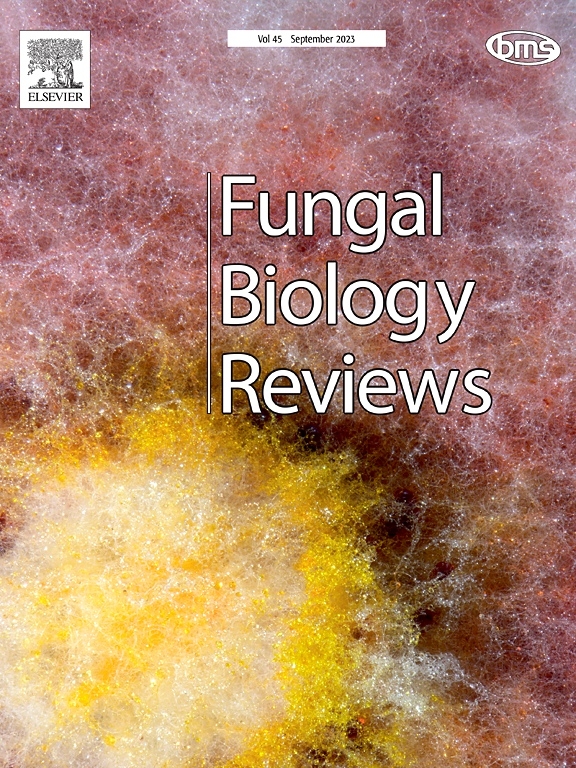Secondary metabolites of lichens: The untapped biomedical and pharmaceutical potential of antimicrobial molecules
IF 4.6
2区 生物学
Q1 MYCOLOGY
引用次数: 0
Abstract
Lichens are formed through a mutualistic interaction between one main fungal species, known as the mycobiont, and algae and/or cyanobacteria species, known as the photobionts. Lichens, particularly the mycobiont component, are known to produce various secondary metabolites which have distinct physiological roles in order to protect from biotic and abiotic stress. This review explores the antimicrobial potential of lichen-derived secondary metabolites, highlighting their efficacy against a variety of microorganisms. Based on a exhaustive analysis of the scientific literature, we discuss the mechanisms of action and potential applications of these metabolites in the fight against antibiotic resistance and emerging infectious diseases. Lichen-derived compounds, such as diffractaic, lobaric, protolichesterinic, salazinic and usnic acid, exhibit diverse antimicrobial properties, demonstrating activity against a wide range of bacteria, fungi and yeasts, often with significant minimal inhibitory concentrations (MICs). Some of them also show promise as antiviral agents. In addition, certain metabolites show synergism with conventional antibiotics, which could enhance their efficacy. Finally, the interaction of molecules present in culture supernatants of lichens and inorganic ions, in the form of nanoparticles, presenting antimicrobial activity, is also described. This literature review highlights the therapeutic potential of lichen metabolites in the fight against various microbial infections, making them valuable targets for future research and drug development.
地衣的次生代谢物:抗菌分子未开发的生物医学和制药潜力
地衣是由一种主要的真菌物种(称为真菌生物)和藻类和/或蓝藻物种(称为光生物)之间的相互作用形成的。众所周知,地衣,特别是菌体成分,可以产生各种次生代谢物,这些代谢物具有不同的生理作用,以保护地衣免受生物和非生物胁迫。本文综述了地衣衍生的次生代谢物的抗菌潜力,强调了它们对多种微生物的功效。基于对科学文献的详尽分析,我们讨论了这些代谢物在对抗抗生素耐药性和新出现的传染病中的作用机制和潜在应用。地衣衍生化合物,如衍射酸、叶酸、原胆甾酸、salazinic和usnic酸,表现出多种抗菌特性,对多种细菌、真菌和酵母具有活性,通常具有显著的最低抑制浓度(mic)。其中一些还显示出抗病毒药物的前景。此外,某些代谢物与常规抗生素具有协同作用,可增强其疗效。最后,还描述了地衣培养上清液中存在的分子与无机离子的相互作用,以纳米颗粒的形式呈现抗菌活性。这篇文献综述强调了地衣代谢物在对抗各种微生物感染方面的治疗潜力,使它们成为未来研究和药物开发的有价值的靶点。
本文章由计算机程序翻译,如有差异,请以英文原文为准。
求助全文
约1分钟内获得全文
求助全文
来源期刊

Fungal Biology Reviews
MYCOLOGY-
CiteScore
10.60
自引率
0.00%
发文量
36
期刊介绍:
Fungal Biology Reviews is an international reviews journal, owned by the British Mycological Society. Its objective is to provide a forum for high quality review articles within fungal biology. It covers all fields of fungal biology, whether fundamental or applied, including fungal diversity, ecology, evolution, physiology and ecophysiology, biochemistry, genetics and molecular biology, cell biology, interactions (symbiosis, pathogenesis etc), environmental aspects, biotechnology and taxonomy. It considers aspects of all organisms historically or recently recognized as fungi, including lichen-fungi, microsporidia, oomycetes, slime moulds, stramenopiles, and yeasts.
 求助内容:
求助内容: 应助结果提醒方式:
应助结果提醒方式:


